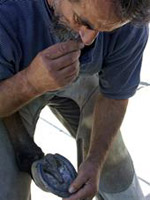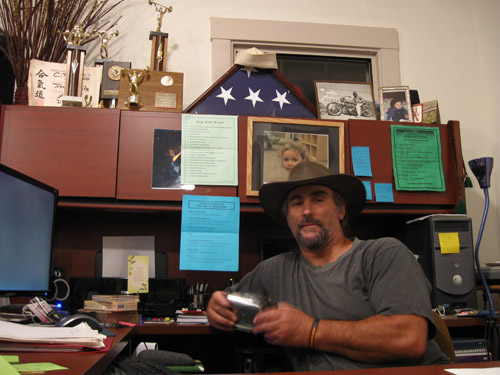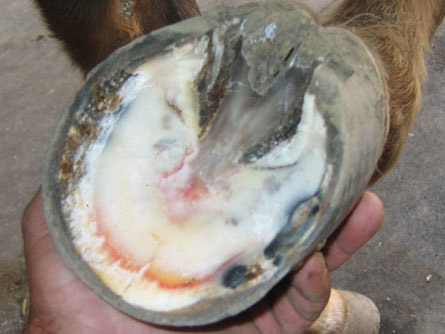 Name
Name
My full name is John Jerome Silveira Jr.
Website & places you can find me online
website: www.Care4Horses.com
Blog: Farrieritis.Care4Horses.com
Informative articles
Follow John on twitter: @Care4Horsescom
Tell us a little about you, what is your background & where do you come from?
Born in San Mateo California in 1953. Raised by my Mother Marie and Father John and have an older sister by 2 years Marilyn and a younge sister by 8 years Tina. Life was good in San Mateo growing up.
I have to say those were the good ole days. There was more freedom, rules and laws were more relaxed
I was an athlete from the start, loved motorcycles from the age of about 11 and had many. Still have a few as well.
I got into weightlifting at the age of 23 and spent nearly 10 years training which won me a championship in California for Olympic Weightlifting and
competed on the National level as well. Had 3 children in my 20’s and currently adore my 7 year old son Tristan.
Owned several auto body shops over the years where i was mostly into custom painting motorcycles boats and vans – Airbrushing – a little of this a little of that.
When did you first decide to become a farrier?
At the end of 1990 I found myself growing weary of the automotive business and was seeking change. Found myself one day reading Western Horseman Magazine in the ad section at the back, say HORSESHOEING SCHOOL and the lightbulbs in my little head went off and about a month later I found myself in Oklahoma at the Farrier school on a Pell Grant from the Gov.

What was it that inspired you?
Just previous to going to Oklahoma I was given a horse by one of my clients at the Auto Body shop. I was fascinated by the big animals. I suppose that was all part of what inspired me to take up horseshoeing.
Have always been good with my hands so it was a good fit for me.
It was interesting having never really been around horses except to rent one a couple times to go horseback riding but while at the Farrier school the owner of the school came up to me about 9 weeks into the 12 week course and took me aside to tell me personally he felt I was one of the best students he’s had come through the school in a couple years. Certainly was a boost to taking up the new trade.
What I would have never realized upon graduating from the school how deeply involved I was to become in the shoeing industry
For one – the day I graduated i just knew on the gut level something was terribly missing from the education, somehow i just knew there was much more to shoeing than was taught. It was in short order that I was to
find out exactly what was missing, and I have to say I was blown away.
These Horses, these are big animals, but at the same time in a way are very delicate sometimes. There definately is a correct way to care for the feet and legs that’s very very important to the longevity of these wonderful Equine friends of ours.
I take shoeing horses very very seriously, I simply MUST. The very nature of the animal demands the utmost – if I miss one step – just one and I put the horse at risk of lameness and I can’t live with that – that’s simply just not good enough.

So I quickly (luckily) found out what was missing from the shoeing process taught to me at the Farrier School and as I evolved and my understanding of what’s really going on with and inside horses feet and legs I was completely blown away.
There really is a kind of Mystery, Secrets if you will hidden inside the horse, and yes I’m referring to shoeing and understanding shoeing.
I spent the next 18 years looking from the inside of shoeing and then out, taking many before and after photos of slight changes in horses feet as I made adjustments to the shoeing process.
Since the feet grow rather slow it’s rather difficult to spot changes (undesirable changes) that occur from improper shoeing as well as making changes for the better to the feet for more correct balance.
So anyway now my whole shoeing method is quite different than what was taught me and to this day (18 years now) I have not had One Single Lame Horse due to my shoeing methods used
And THAT is Cool! Beyond cool! In hindsight if I had been one of those kinda guys that have their horses coming up lame (which many do come up lame) I don’t think I could have lived with that and I’m certain I would have given up on the profession.
Now i just really really like sharing this information and helping people with their horses who are having problems with lameness. It’s really very gratifying.
What’s interesting is since TRUE BALANCE is so little understood and practiced most people, Farriers included, just don’t have the full picture about the truth. So basically many are so in the dark about what’s really going on with the horse’s legs and feet and as a result shoeing in general can be taken as something that’s really not so significant or very important and nothing can be farther from the truth.
Little changes in the feet can have disastrous effects on the horse’s and it’s rather a sad state of affairs when sometimes trying to explain these shoeing concepts to new clients the words are overlooked and trivialized. It’s like then I need to go Knock Knock Knocking on the clients head
diplomatically to kinda wake them up.
It’s just part of the job (-:

In your opinion, is barefoot really better?
You ask me if barefoot horses or the barefoot horse is better and I resoundingly say “NO”. How would I be able to say barefoot horses are better when i’ve had an 18 long years success track record.
Maybe that’s not a fair statement – and this is a rather touchy subject for many, I know but here’s some facts.
Not all horses can go barefoot – many just aren’t able to , their feet will just never toughen up to the task. Where as I really can’t site a case where a horse cannot wear shoes. So right off the bat the percentage of horses capable of wearing shoes over horses going barefoot is greater.
There is also a great tendency, and my findings are approximately 98%, that horses are inherantly out of balance. The problem with the barefoot horse is that this inherant out of balance condition is much more difficult to adjust without the use of shoes.
That’s not to say that the shoeing has to be a permanent condition, rather shoeing is used as a temporary measure to condition the feet
and adjust – stimulate feet into balance, then go ahead and try going barefoot. But not until true balance has been achieved through shoeing. Make no mistake, when it comes to horses feet we’re talking about some very complex issues, it came as a huge surprise to me just how much so in fact.
Seriously, shoeing goes much much deeper than most people ever realize when it comes to their horses and as such (not to beat up on the general horse owner populace).
Without full appreciation and understanding of your horses legs and feet I feel there’s a big missing piece to true Horsemanship itself
If you can know feet and legs inside and out it’s in a word, enlightening and I promise you your skills on horseback will improve.
This is magic! This is why I’ve called horseshoeing a mystery and the missing link. It’s very powerful.
I always say ” It only takes once for your horse to come up permanently
lame”.
But Wait, There’s More
John has plenty more to share about problems with the farrier industry, his favorite horse breed and how the internet has revolutionized his life’s work. Be sure to check out Pt 2 of John’s interview.